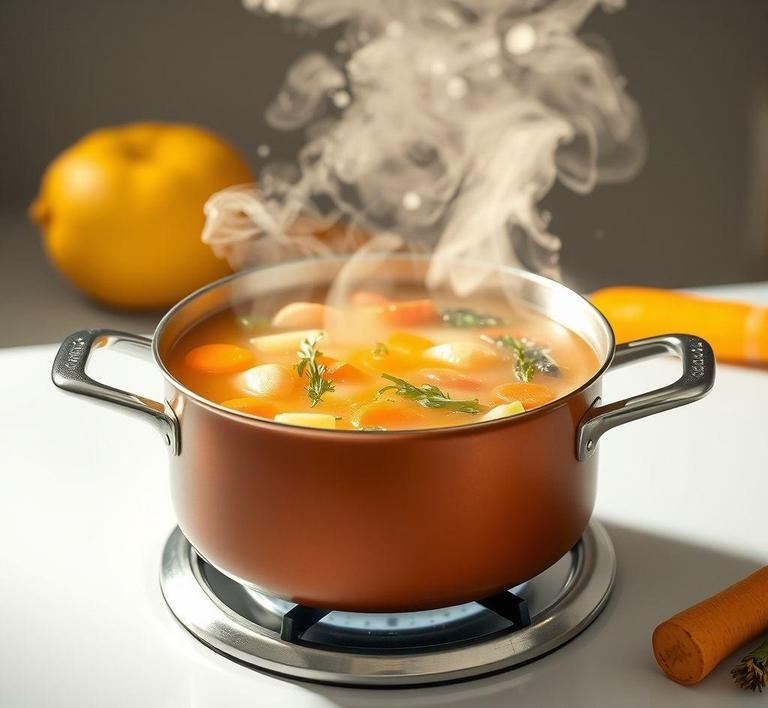If you’ve made a big batch of homemade chicken stock and find yourself with leftovers, you might be wondering if it’s safe to refreeze it. The answer is yes, but there are some important things to consider to make sure your stock stays flavorful and safe to eat. Refreezing chicken stock can be a great way to preserve it for future use, but you’ll need to follow some simple steps to avoid compromising its taste or texture. In this guide, we’ll walk you through the best practices for safely refreezing chicken stock, from how to store it properly to how to thaw it out when you’re ready to use it again. Let’s dive in!
Can You Refreeze Chicken Stock?

The question of whether or not you can refreeze chicken stock might sound straightforward, but it actually involves a deeper look at food safety, quality preservation, and proper storage techniques. To begin with, the simple answer is yes, you can refreeze chicken stock. However, doing so is not always the best choice if you want to maintain the stock’s original flavor and texture.
The key here is understanding what happens to liquid-based foods, like chicken stock, when they’re frozen and thawed multiple times. Freezing, in itself, is a process that halts the growth of bacteria, which is why it’s an excellent method of preserving food for longer periods. But when food is thawed, the bacteria that might have been present before freezing can become active again. Refreezing brings its own set of considerations, particularly concerning texture changes and food safety.
Chicken stock is a delicate blend of flavors, fats, and liquids. When you freeze it, ice crystals form, and the liquid can separate slightly. Thawing allows those components to blend again. But if this process happens repeatedly, the flavors might weaken, and the texture can degrade. For example, chicken fat can rise to the top and separate from the broth, resulting in an uneven consistency once refrozen and thawed again.
How To Refreeze Chicken Stock?
Refreezing chicken stock isn’t a process you should take lightly, but if you decide to go ahead, here’s how to do it safely and preserve as much of the quality as possible:
- Cool the Stock Properly Before Freezing: After making your chicken stock or thawing it from a previous freeze, always ensure it cools down to room temperature before you place it back in the freezer. The longer it sits at a warm temperature, the higher the risk of bacteria growth. Ideally, stock should be cooled and frozen within 2 hours to avoid any safety issues.
- Divide the Stock into Smaller Portions: When freezing chicken stock, it’s best to portion it out into smaller containers or ice cube trays. This way, you don’t have to defrost the entire batch just to use a small amount, reducing the number of times you need to refreeze it. This will help maintain the stock’s flavor integrity.
- Use Airtight Containers: Store the stock in air-tight containers or freezer bags to avoid freezer burn. Freezer burn can dry out the surface of your stock, making it taste bland and stale.
- Label and Date Your Stock: Always mark your containers with the date you are freezing the stock. This is important because while chicken stock can last in the freezer for up to 6 months, its quality will decline with each refreezing. By keeping track of when it was originally frozen, you can manage its use more efficiently.
- Thawing and Refreezing Carefully: When you’re ready to use the stock again, make sure to thaw it safely in the refrigerator. Never thaw it at room temperature, as this can allow bacteria to multiply. Once it’s fully thawed, you can reheat it and check for any separation in the fats or liquid. Stir it well to reintegrate the components before using.
- Avoid Thawing and Refreezing Multiple Times: Ideally, chicken stock should only be thawed once and refrozen once. Each additional thaw-refreeze cycle can further degrade the stock’s quality and safety. If you find yourself frequently needing to refreeze, it’s worth reconsidering how you portion out and store the stock to avoid this.
Quality Impact
Refreezing chicken stock can have some noticeable effects on both flavor and texture, so it’s important to manage how you handle your stock. Here’s a closer look at the potential quality impacts:
- Texture Changes: The most significant change you’ll notice after refreezing chicken stock is in the texture. The freezing process causes ice crystals to form, which can rupture the cells within the liquid. While this doesn’t usually result in a completely ruined texture, the stock might become slightly more watery or have a more ‘grainy’ texture, particularly if the stock contains a lot of fat. This fat can separate from the liquid and create a greasy or inconsistent texture when refrozen.
- Flavor Degradation: One of the biggest drawbacks of refreezing chicken stock is flavor loss. Each time the stock is frozen and thawed, the flavors can become less pronounced. The herbs, spices, and aromatics you used in the initial stock may lose their vibrancy. Additionally, because the fat may separate and congeal, some of the rich, meaty flavors of the stock could be compromised.
- Separation of Fat and Liquid: As mentioned, chicken stock contains both fat and liquid. When the stock freezes, these components can separate. If not properly mixed when thawed, the stock could appear oily or chunky. Refreezing could exacerbate this issue, making it harder to reincorporate the fat with the broth. This might lead to a less smooth and cohesive texture.
- Nutrient Loss: Although freezing and refreezing don’t significantly impact the nutritional content of chicken stock (since the liquid itself contains a lot of water and protein), the breakdown of fats over multiple freezing cycles can cause some of the stock’s nutritional profile to decline. The more times you freeze and thaw the stock, the more likely it is that nutrients like essential fatty acids and vitamins can be compromised.
While you can refreeze chicken stock, it’s not always advisable to do so frequently. The process of freezing and thawing can degrade both the texture and flavor, and while refrozen stock might still be usable, its quality will likely suffer. If you must refreeze chicken stock, make sure to follow proper storage techniques: cool it quickly, divide it into portions, and store it in airtight containers. Always thaw it safely, and try to limit the number of times you freeze and thaw.
Ultimately, it’s a matter of balance: if you have extra stock that you can’t use immediately, freezing is a great way to extend its shelf life. But if you’re aiming for the best flavor and texture, it’s best to use stock within a reasonable amount of time and avoid multiple freeze-thaw cycles. So while it’s okay to refreeze, think twice about how often you put your chicken stock through this process to preserve its delicious, savory qualities.
Is It Safe To Refreeze Chicken Stock?
Refreezing chicken stock, like any other food item, is a topic that many people are cautious about. The short answer to whether it is safe to refreeze chicken stock is yes, but with conditions. The safety largely depends on how the stock was originally frozen, how it’s been handled, and how long it has been stored.
When chicken stock is made, it’s typically simmered from chicken bones, vegetables, and herbs, often resulting in a flavorful and nutritious liquid. However, due to its high water content and the presence of proteins and fats, chicken stock can be susceptible to bacterial growth if not handled properly. This is where refreezing comes into play.
The Risks Involved:
Refreezing chicken stock can increase the risk of foodborne illness if the stock has not been cooled or stored properly. For example, if the stock was left out at room temperature for too long before being frozen or if it thawed improperly (e.g., in the microwave or at room temperature), bacteria could multiply, making the stock unsafe to refreeze.
However, if the stock has been kept at a safe temperature (below 40°F or 4°C) during its initial thawing process, and if it hasn’t been left out for more than two hours, then it can be refrozen without posing much risk. The key is in the proper handling from the start.
The Texture and Flavor Impact:
One of the considerations when refreezing chicken stock is the quality of the stock after thawing and refreezing. Freezing causes the water in the stock to expand, which can break down the cell structure of the ingredients. This means that once the stock is thawed and refrozen, the texture and flavor may degrade. The consistency may be affected as well, with the fat separating from the stock upon reheating. But, this does not make it unsafe-it’s simply a matter of quality.
Signs That Chicken Stock Should Not Be Refrozen
While it may be technically safe to refreeze chicken stock under certain conditions, there are several signs that indicate it should not be refrozen, as it may no longer be safe or enjoyable to consume. These signs include:
-
Off Smell:
If the chicken stock develops a sour, rancid, or off smell after thawing, it’s a clear sign that bacterial growth has occurred, and the stock should be discarded. The smell is often the first indicator that the stock has gone bad.
-
Cloudy or Slimy Texture:
A slimy or excessively cloudy appearance is another red flag. While some cloudiness is normal in stock, a sudden shift in texture or the presence of unusual sliminess suggests spoilage. This is usually a result of improper thawing or the growth of bacteria.
-
Change in Color:
If the color of the chicken stock changes significantly (for example, from golden brown to a darker or murkier shade), it’s a good indication that something is wrong. Color changes often occur due to the breakdown of fats and proteins, and they can signal bacterial contamination.
-
Excessive Ice Crystals or Frozen Layers:
If the stock has developed large ice crystals or thick frozen layers, this could suggest it was not cooled down properly before being frozen or thawed. This could lead to a loss of flavor or texture, and if it’s thawed and refrozen multiple times, it may become less palatable.
Common Refreezing Mistakes
When refreezing chicken stock, even experienced cooks can make a few common mistakes that lead to a decline in both safety and quality. Avoiding these pitfalls will ensure that your stock stays both safe and tasty:
-
Thawing at Room Temperature:
One of the most common mistakes people make is thawing chicken stock at room temperature. While it’s tempting to let stock thaw quickly by leaving it out on the counter, this can lead to rapid bacterial growth. Always thaw chicken stock in the refrigerator or use the defrost function on the microwave, ensuring it stays at a safe temperature (below 40°F) during the process.
-
Refreezing After Extended Thawing:
Chicken stock should never be refrozen if it has been left out at room temperature for more than two hours. Bacteria can multiply quickly in this "danger zone" (between 40°F and 140°F). If the stock has thawed for too long, it’s better to discard it rather than risk foodborne illness.
-
Not Cooling the Stock Before Freezing:
If you don’t allow chicken stock to cool completely before freezing, the warmer temperature can increase the chances of bacterial growth, making the freezing process unsafe. Always let the stock cool to room temperature or below before freezing, and store it in shallow containers to speed up the cooling process.
-
Freezing in Large Quantities:
Refreezing large portions of chicken stock can be cumbersome and result in uneven thawing. It’s better to freeze stock in smaller portions (using ice cube trays or small containers) so that you only thaw what you need, minimizing the number of times the stock goes through the freezing and thawing cycle.
Tips And Tricks
To maximize the quality and safety of your chicken stock when freezing, refreezing, and thawing, here are some useful tips and tricks:
-
Cool Stock Rapidly:
To prevent bacterial growth, cool your chicken stock rapidly before freezing. You can do this by dividing the stock into smaller containers, which will allow it to cool faster. Alternatively, you can place the pot of stock in an ice bath (a larger container of ice water) to bring down the temperature quickly.
-
Use Ice Cube Trays:
Freeze chicken stock in ice cube trays for easy portioning. This method allows you to thaw only the amount you need for a recipe, without having to thaw the entire batch, which helps preserve the quality.
-
Label Your Stock:
Always label the containers with the date of freezing. Chicken stock can last in the freezer for 2-3 months. By marking the date, you can easily monitor how long it’s been stored and avoid using stock that may be past its prime.
-
Freeze with Herbs and Spices:
If you like to add herbs or seasonings to your chicken stock, you can freeze them with the stock. This way, when you thaw the stock for future use, it’s already seasoned, saving you time in meal prep.
-
Avoid Refreezing Multiple Times:
Try to avoid refreezing stock more than once. Each cycle of freezing and thawing affects the flavor and texture, so it’s best to minimize this process as much as possible. If you have leftovers, portion them out for easier future use.
Conclusion
In conclusion, refreezing chicken stock is generally safe, provided the stock is handled properly throughout the freezing, thawing, and refreezing process. The risks mainly come from improper thawing or leaving stock at unsafe temperatures for extended periods. By following best practices-such as rapid cooling, portioning, and proper storage-you can ensure the safety of your stock while maintaining its flavor and texture. Keep an eye out for signs of spoilage, and always prioritize safety over convenience. With the right steps, you can enjoy your homemade stock for weeks to come without sacrificing its quality.


